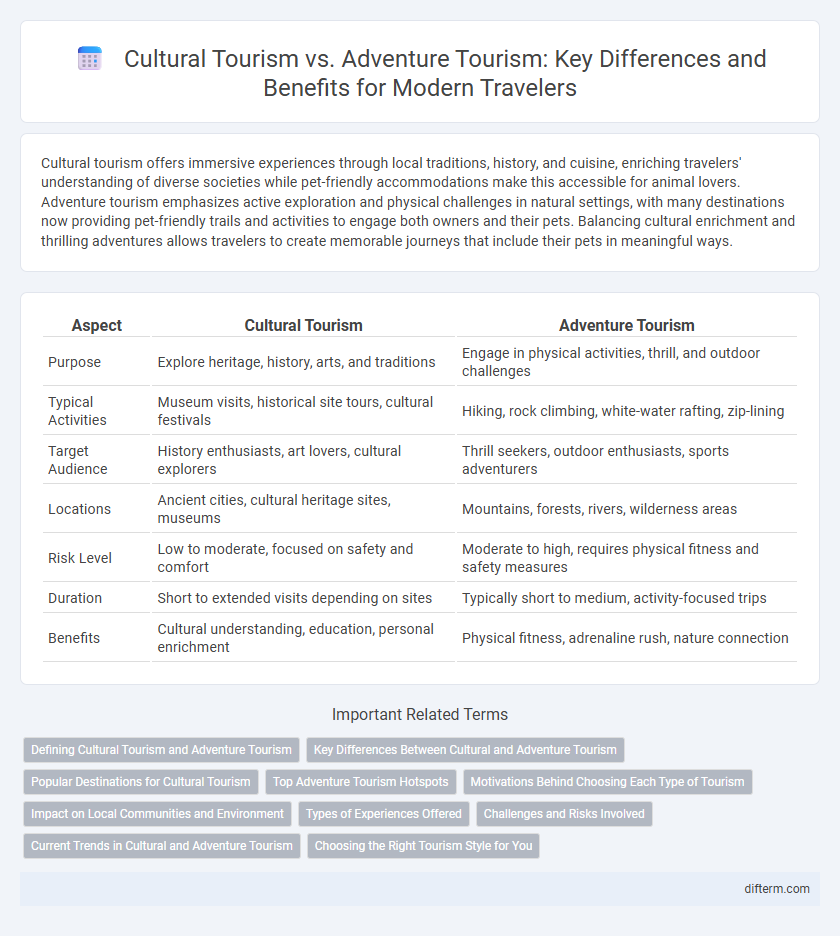Cultural tourism offers immersive experiences through local traditions, history, and cuisine, enriching travelers' understanding of diverse societies while pet-friendly accommodations make this accessible for animal lovers. Adventure tourism emphasizes active exploration and physical challenges in natural settings, with many destinations now providing pet-friendly trails and activities to engage both owners and their pets. Balancing cultural enrichment and thrilling adventures allows travelers to create memorable journeys that include their pets in meaningful ways.
Table of Comparison
| Aspect | Cultural Tourism | Adventure Tourism |
|---|---|---|
| Purpose | Explore heritage, history, arts, and traditions | Engage in physical activities, thrill, and outdoor challenges |
| Typical Activities | Museum visits, historical site tours, cultural festivals | Hiking, rock climbing, white-water rafting, zip-lining |
| Target Audience | History enthusiasts, art lovers, cultural explorers | Thrill seekers, outdoor enthusiasts, sports adventurers |
| Locations | Ancient cities, cultural heritage sites, museums | Mountains, forests, rivers, wilderness areas |
| Risk Level | Low to moderate, focused on safety and comfort | Moderate to high, requires physical fitness and safety measures |
| Duration | Short to extended visits depending on sites | Typically short to medium, activity-focused trips |
| Benefits | Cultural understanding, education, personal enrichment | Physical fitness, adrenaline rush, nature connection |
Defining Cultural Tourism and Adventure Tourism
Cultural tourism involves exploring destinations to experience local traditions, history, art, and heritage, often through museums, festivals, and historical sites. Adventure tourism emphasizes active, physically challenging activities such as hiking, climbing, or rafting in natural environments. Both forms of tourism offer distinct opportunities for immersive experiences, with cultural tourism enriching knowledge and adventure tourism providing adrenaline-fueled excitement.
Key Differences Between Cultural and Adventure Tourism
Cultural tourism emphasizes immersive experiences in history, art, and local traditions, often involving visits to museums, historical sites, and festivals. Adventure tourism prioritizes physical activities and thrill-seeking, such as hiking, rafting, or mountain climbing in natural landscapes. The key differences lie in the focus on intellectual enrichment and heritage preservation for cultural tourism versus adrenaline-driven outdoor challenges in adventure tourism.
Popular Destinations for Cultural Tourism
Popular destinations for cultural tourism include cities rich in history and heritage such as Rome, Kyoto, and Cairo, where travelers can explore ancient architecture, museums, and traditional art forms. These locations offer immersive experiences through local festivals, culinary traditions, and historic landmarks that highlight the unique identity of each culture. Cultural tourism attracts visitors seeking educational and meaningful interactions with the customs, rituals, and lifestyles that define diverse societies worldwide.
Top Adventure Tourism Hotspots
Top adventure tourism hotspots include Queenstown in New Zealand, known for bungee jumping and skydiving, and Costa Rica's rainforests offering zip-lining and white-water rafting experiences. These destinations appeal to thrill-seekers seeking physical challenges and adrenaline-pumping activities, contrasting with cultural tourism that emphasizes heritage sites, museums, and local traditions. Adventure tourism locations often feature rugged landscapes and outdoor sports, attracting travelers focused on active, experiential trips rather than cultural immersion.
Motivations Behind Choosing Each Type of Tourism
Cultural tourism attracts travelers motivated by a desire to explore historical landmarks, experience local traditions, and engage with diverse communities to gain deeper insights into different ways of life. Adventure tourism appeals to those seeking physical challenges, adrenaline-pumping activities such as hiking, scuba diving, or mountain biking, and immersive nature experiences that push personal limits. Both forms of tourism fulfill distinct psychological needs: cultural tourism emphasizes intellectual enrichment and connection, while adventure tourism focuses on excitement and personal achievement.
Impact on Local Communities and Environment
Cultural tourism fosters preservation of heritage sites and supports local artisans, generating income for communities while promoting sustainable practices that respect traditions. Adventure tourism often drives economic growth through increased demand for outdoor activities but can strain natural resources and disrupt wildlife habitats if not managed responsibly. Effective tourism planning balances economic benefits with minimizing environmental footprints and protecting cultural authenticity to ensure long-term community well-being.
Types of Experiences Offered
Cultural tourism offers immersive experiences such as exploring historical landmarks, engaging with local traditions, and attending authentic festivals. Adventure tourism focuses on physically demanding activities like hiking, scuba diving, and extreme sports that challenge personal limits. Both types provide unique opportunities for travelers to connect with destinations, but cultural tourism emphasizes heritage and education, while adventure tourism prioritizes thrill and physical engagement.
Challenges and Risks Involved
Cultural tourism faces challenges such as preserving local heritage sites while managing tourist impact and ensuring respectful interactions with indigenous communities. Adventure tourism involves risks like unpredictable weather, physical injuries, and the need for specialized equipment and trained guides to ensure safety. Both types require sustainable practices to balance tourist enjoyment with environmental and cultural preservation.
Current Trends in Cultural and Adventure Tourism
Current trends in cultural tourism emphasize authentic local experiences, heritage site preservation, and immersive interactions with indigenous communities, driven by travelers seeking meaningful connections with diverse cultures. Adventure tourism is evolving through the integration of eco-friendly practices, technological innovations like virtual reality previews, and increased demand for sustainable, low-impact outdoor activities such as hiking, kayaking, and wildlife safaris. Both sectors show growth influenced by a rising preference for personalized, experiential travel combined with environmental consciousness and digital engagement tools.
Choosing the Right Tourism Style for You
Cultural tourism offers immersive experiences in heritage sites, museums, and local traditions, ideal for travelers seeking to understand history and community life. Adventure tourism emphasizes activities like hiking, rafting, and extreme sports, appealing to those who prioritize physical challenges and adrenaline. Assessing personal interests, physical fitness, and desired travel outcomes helps determine whether cultural exploration or adventure pursuits best suit your travel style.
cultural tourism vs adventure tourism Infographic

 difterm.com
difterm.com